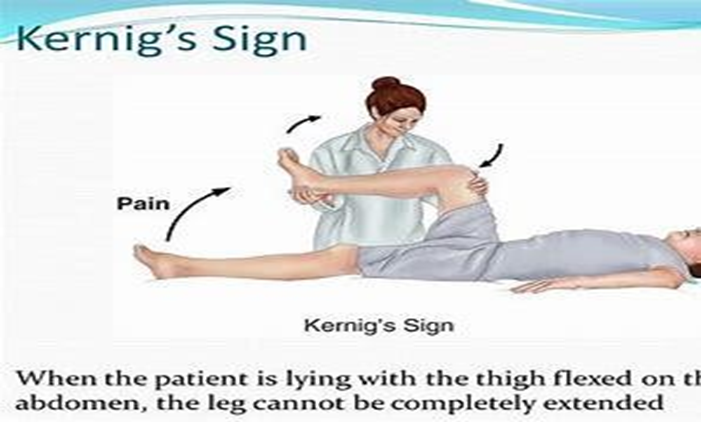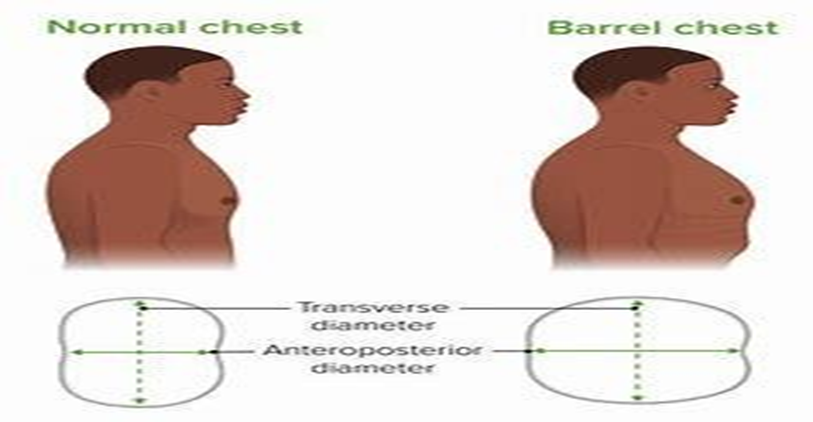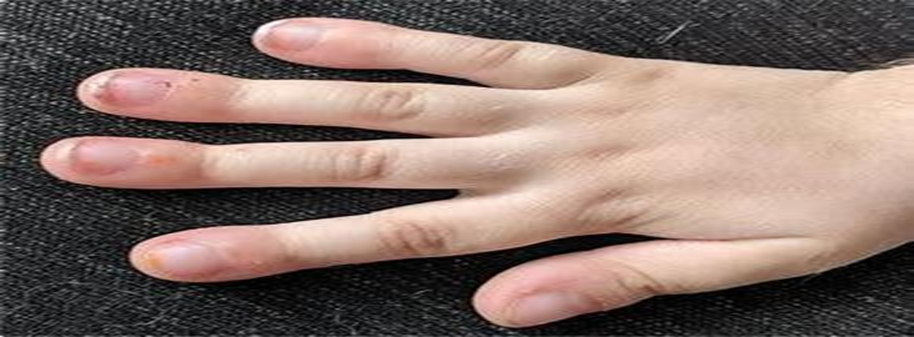The nurse notes documentation that a child with meningitis is exhibiting a positive Kernig's sign. Which observation is a characteristic of this sign?
Petechial and purpuric rashes are noted on the child's trunk
Neck flexion causes adduction and flexion movements of the lower extremities
The child is not able to extend the leg when the thigh is flexed anteriorly at the hip
The child complains of muscle and joint pain
The Correct Answer is C
C. This is characteristic of Kernig's sign. Kernig's sign is elicited when the thigh is flexed at the hip and then attempts to extend the leg at the knee are met with resistance or pain due to inflammation of the meninges.

A. Petechial and purpuric rashes are associated with meningococcal meningitis, not specifically with Kernig's sign. These rashes result from bleeding into the skin and are a characteristic feature of meningococcal sepsis. However, they are not directly related to Kernig's sign.
B. This observation describes Brudzinski's sign, not Kernig's sign. Brudzinski's sign occurs when passive flexion of the neck causes involuntary flexion of the hips and knees due to meningeal irritation.
D. Muscle and joint pain can be symptoms of meningitis, but they are not specific to Kernig's sign. Kernig's sign specifically refers to resistance or pain experienced when attempting to extend the leg at the knee.
Nursing Test Bank
Naxlex Comprehensive Predictor Exams
Related Questions
Correct Answer is D
Explanation
D. If the tympanostomy tubes fall out, the parent should contact the healthcare clinic or the healthcare provider who performed the procedure. They can provide guidance on whether the child needs to be seen for an evaluation and potential replacement of the tubes. Reporting the situation allows for appropriate follow-up and management by the healthcare team.
A. Tympanostomy tubes are small tubes inserted into the eardrums to help drain fluid from the middle ear and prevent recurrent ear infections. While they are designed to stay in place for a certain period, it is possible for them to fall out prematurely.
B. It's important for the parent to seek medical advice if the tubes fall out but it may not always require an immediate visit to the emergency department. However, if the child experiences severe pain, bleeding, or signs of infection after the tubes fall out, seeking urgent medical attention may be warranted.
C. Only a healthcare provider should insert or reinsert tympanostomy tubes. Attempting to reinsert the tubes at home without proper training and equipment could cause injury or damage to the ear.
Correct Answer is ["A","B","D"]
Explanation
A. Wheezing. Cystic fibrosis can cause airway obstruction due to thickened mucus, leading to wheezing and difficulty breathing, especially during respiratory infections or exacerbations.
B. A barrel-shaped chest is often seen in advanced stages of cystic fibrosis. It results from hyperinflation of the lungs due to air trapping, chronic lung disease, and repeated respiratory infections. The chest appears rounded and enlarged, similar to the shape of a barrel.

D. Clubbing of fingers and toes is a common finding in cystic fibrosis. It is caused by chronic hypoxia and inadequate oxygenation of tissues, leading to changes in the nail beds and fingertips. Clubbing typically develops over time in individuals with chronic respiratory conditions, including cystic fibrosis.

C. Thin, watery mucous is not expected in cystic fibrosis. Instead, cystic fibrosis is characterized by thick, sticky mucus due to dysfunction of the exocrine glands, leading to blockages in the airways, pancreas, and other organs.
E. Rapid growth spurts are not typically associated with cystic fibrosis. In fact, children with cystic fibrosis may experience growth failure or delayed growth due to malabsorption of nutrients, chronic illness, and increased energy expenditure.
Whether you are a student looking to ace your exams or a practicing nurse seeking to enhance your expertise , our nursing education contents will empower you with the confidence and competence to make a difference in the lives of patients and become a respected leader in the healthcare field.
Visit Naxlex, invest in your future and unlock endless possibilities with our unparalleled nursing education contents today
Report Wrong Answer on the Current Question
Do you disagree with the answer? If yes, what is your expected answer? Explain.
Kindly be descriptive with the issue you are facing.
